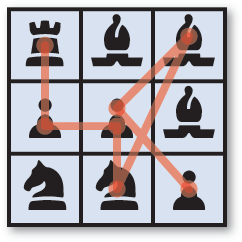Wildcard Chess Mazes
1st August 2017
This month I've revisited a type of maze I designed about five years ago. It's a variant of the Chess Mazes called a Wildcard Chess Maze, which adds a wildcard piece, represented by a pawn, that mimics the moves of the previous piece you were on.
Here's an example:

Each piece you land on determines where you can move next. From a bishop you can move diagonally, and from a castle you can move horizontally or vertically. From a knight you can jump in an L-shaped knight's move, and only the knight can jump over other pieces.
The pawn is a wildcard - it mimics the last piece you were on. So when you land on a pawn, the pawn behaves in the same way as the previous piece.
Start from the rook in the top left corner, and find the shortest route to the pawn in the bottom right corner.
Here's a solution:

There's actually a second solution, also with 6 steps - can you spot it?
The addition of the wildcard rule changes the normal Chess Maze into a state maze, in which the move from a cell can depend on how you got there. In the above example the pawn on the central square acts first as a rook and then as a bishop.
For a simple example of a Wildcard Chess Maze try the original one I designed, Chameleon. Then, for a significantly harder one try this month's competition maze, Cuckoo.
blog comments powered by Disqus
